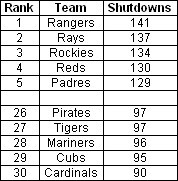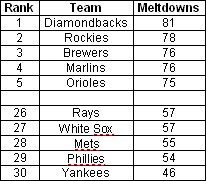Matt Cain’s Pitch Selection by Count
Matt Cain effectively eliminated the Rockies from playoff contention yesterday afternon, pitching a no-hitter into the 8th inning and finishing all nine innings allowing two earned runs with eight strikeouts and one walk. Cain has been able to keep the HR/FB ratio down from 8.4% last season to 6.4% this season, reducing his HR/9 from 0.91 to 0.77. Dropping to 7.06 K/9 from 8.45 K/9 in his first full season (back in 2006) may be a concern, but overall, Matt Cain is enjoying the best season of his career in terms of FIP, with a career low mark of 3.54. Yesterday, Cain was able to induce 13 swinging strikes using all four of his pitches: four-seam fastball, slider, curveball, and changeup.
A pitcher with a variety of pitch types like Matt Cain will mix them based on the count and the batter’s handedness. What would be interesting to investigate is how Cain uses his fastball, silder, curveball, and changeup based on the count. First, let’s look at how many pitches Cain has thrown for each count this season:
All effective pitchers will avoid the three ball count as much as possible, and Cain has thrown 38 3-0 pitches all season in 210.1 IP. Next, let’s look at Cain’s pitch selection by count by first looking at how often he throws the four-seam fastball by count, while referring to the sample size from the above table to keep ourselves honest:
Obviously, Cain uses his fastball most frequently, but notice how he uses the fastball more when there are more balls in the count. In these situations, Cain would want to throw a strike, so using a pitch that he has more control over makes sense. On two strikes against both hitters, Cain throws the fastball about or over 50% of the time. Let’s look at Cain’s slider use by count:
Cain’s slider moves away from RHH and in on LHH. As a result, he rarely uses his slider against LHH in all counts, occasionally using it on two strikes. But against RHH, Cain utilizes the slider up to 20.5% of the time depending on the count. Let’s take a look at Cain’s curveball use:
Cain uses the curveball more often on the first pitch against LHH than against RHH, but uses the curveball as much as the slider on two strikes against RHH. It seems that, in addition to the fastball, Cain likes to use both the slider and curveball as his punch-out pitch against RHH. Finally, let’s look at Cain’s changeup use by count:
Whereas Matt Cain uses his slider against RHH often, he utilizes his changeup against LHH. This is because Cain’s changeup has different horizontal movement than his slider, moving toward RHH and away from LHH instead. Pitches that move away from the batter are harder to hit, so it makes sense that Cain distributes his slider and changeup in this way based on the batter’s handedness. It’s interesting to note that Cain rarely uses his changeup against LHH on the first pitch (12.5%), but uses it more frequently in every other count (up to 33.7% with a 1-1 count) except when there are three balls.
Cain is scheduled for one more start this season — this weekend against the San Diego Padres. The Padres and Giants are locked in a battle for first in the NL West, with the Braves battling for the NL Wild Card spot, as well. For the Padres’ lineup to be successful against Cain, the right-handed hitters could either sit on the fastball or anticipate the breaking ball with two strikes, while the left-handed hitters can expect a timely changeup deep in the at-bat.









